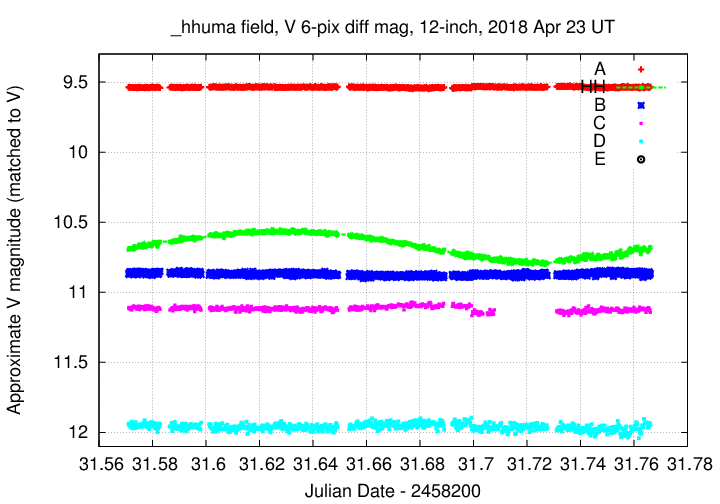
On the night of Apr 22/23, 2018, students in the Observational Astronomy class, led by Dr. Jen Connelly and AST grad student Emily Wilson, made measurements of the eclipsing binary star HH UMa.
in the wee hours of the morning, I acquired a set of observations of the likely black-hole system MAXIJ1820+070, (also known as ASASSN-18ey ). Conditions were very good -- dark and clear.
I'm still working on the vertical stripes ...
Members of the PHYS 373 "Observational Astronomy" class spent the first half of the night observing the eclipsing binary star HH UMa. It's an old favorite -- we've observed it many times from RIT Obs and from Kitt Peak. I'll skip the details, but show a preliminary version of the light curve one can derive from these measurements.

The main setup was:
Notes from the night:
This optical and X-ray and radio transient is likely a black hole accreting material at a higher-than-usual rate. It has been the subject of many observers over the past two weeks -- see the trail of telegrams that include
The object is located at
RA = 18:20:21.9 Dec = +07:11:07.3
A chart of the field is shown below. The size of the chart is about 22 by 18 arcminutes.
I've marked the location of several comparison stars, which also appear in light curves below. Stars C, D, and E are mentioned by the Tomoe Gozen team in ATel 11426, but all three are rather red, with (B-V) ranging from 1.14 to 1.37. Star B is one of the bluest nearby bright stars, with (B-V) = 0.52.
star UCAC4 B V ---------------------------------------------------- B 486-079513 12.975 12.454 C 486-079608 13.968 12.830 D 486-079523 14.637 13.272 E 487-077858 14.637 13.272 ----------------------------------------------------
The dark current was ordinary. All the darks were taken at dawn, after all the target images.

The smooth sky value indicates that any clouds were very thin. However, again we see the semi-periodic variation in sky value with amplitude. Still a mystery.

Speaking of tracking, here's the tail of the trail. Guiding was turned off, and the telescope drifted quite a bit.
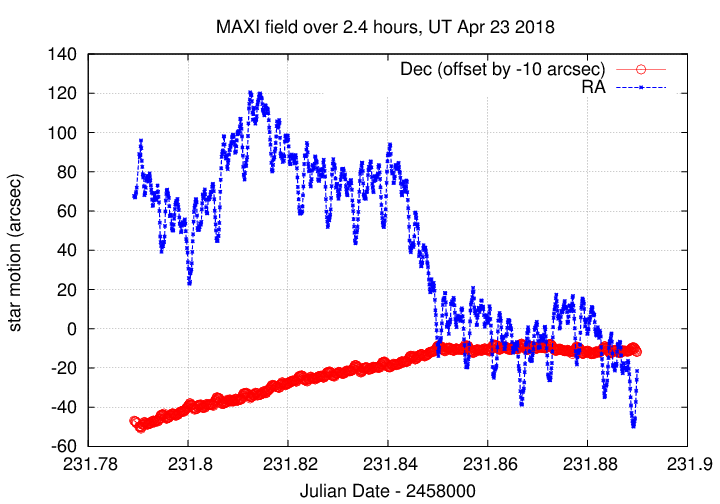
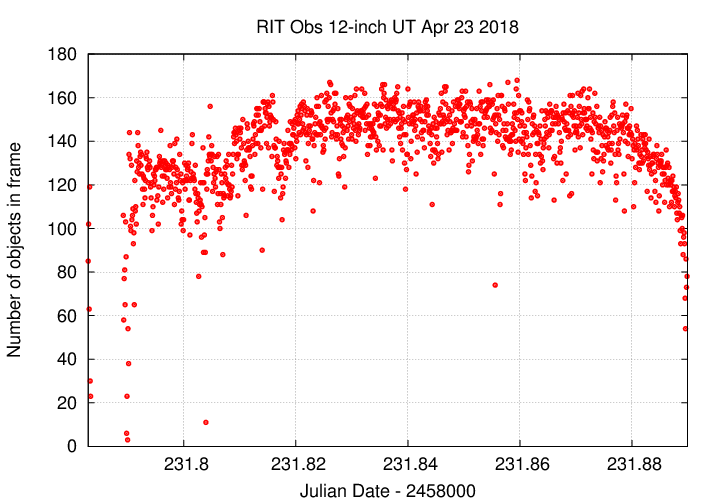
I used an aperture with radius 3.0 pixels, as usual. The seeing and focus were good tonight.

Image adjustment factor shows a bit of clearing early.
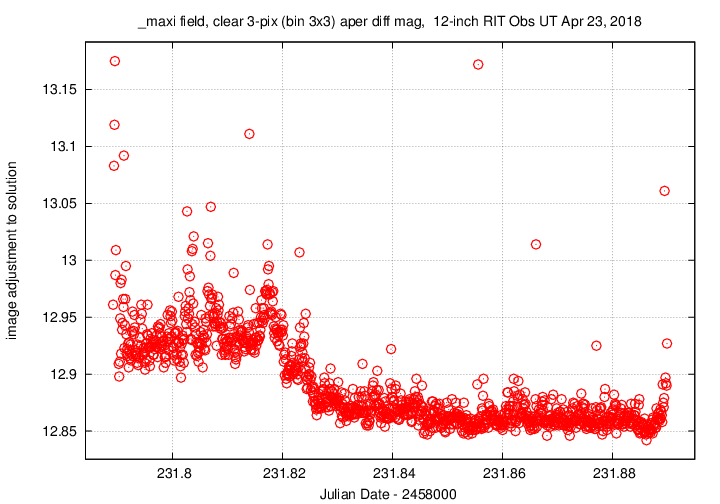
Using aperture photometry with a radius of 3 pixels (binned 3x3, each pixel is 1.98 arcsec, so a radius of 5.9 arcsec), I measured the instrumental magnitudes of a number of reference stars and the target. Following the procedures outlined by Kent Honeycutt's article on inhomogeneous ensemble photometry, I used all stars available in each image to define a reference frame, and measured each star against this frame.
Sigma-vs-mag plots show that the floor was about 0.007 mag overall -- that's about the best I've seen with 5-second exposures. The brightest outlier is a saturated star, and the outlier around instrumental magnitude 2 is MAXI J1820+070.
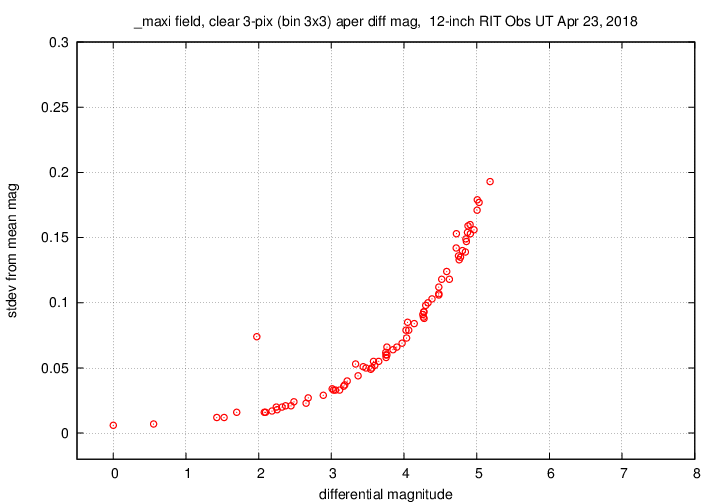
Here are light curves of the variable and the field stars.
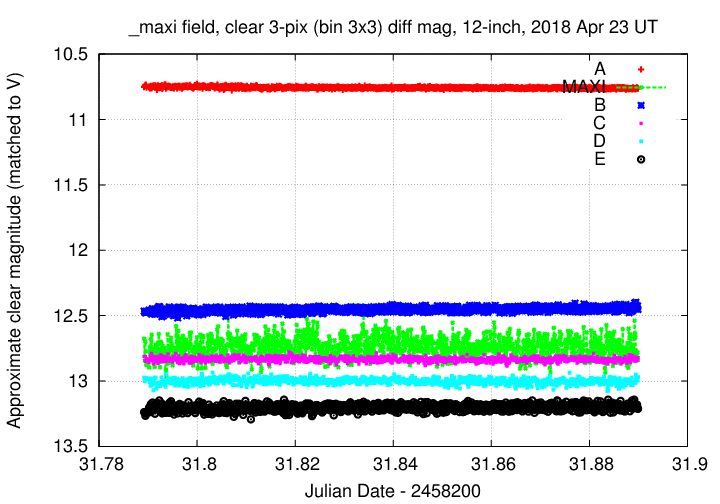
I used the UCAC value for the V-band magnitude of star "B" = UCAC4 486-079513 to shift the ensemble magnitudes to the standard V-band scale -- but remember that these are UNFILTERED measurements.
Here's a closeup on the variable. I'll connect the dots to make its behavior a bit easier to see. Note, as usual, that star B (and presumably the variable) creep up in brightness as they rise out of the East, due to differential extinction and their blue color.
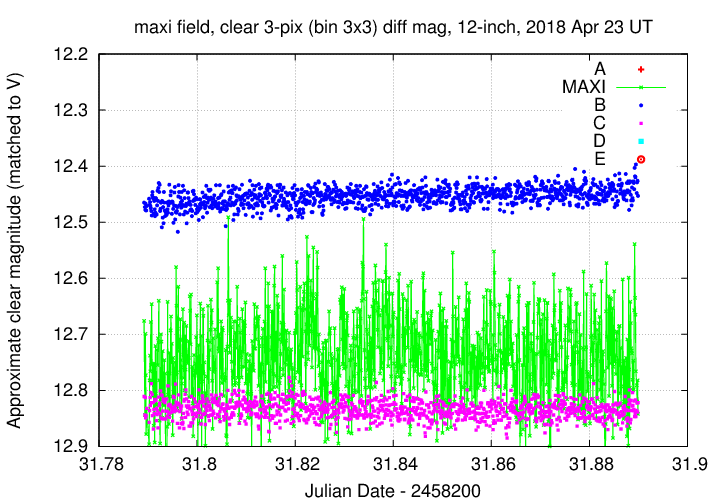
A very short section of the light curve shows some of the variations more clearly. I _think_ those are some really, resolved brightenings.
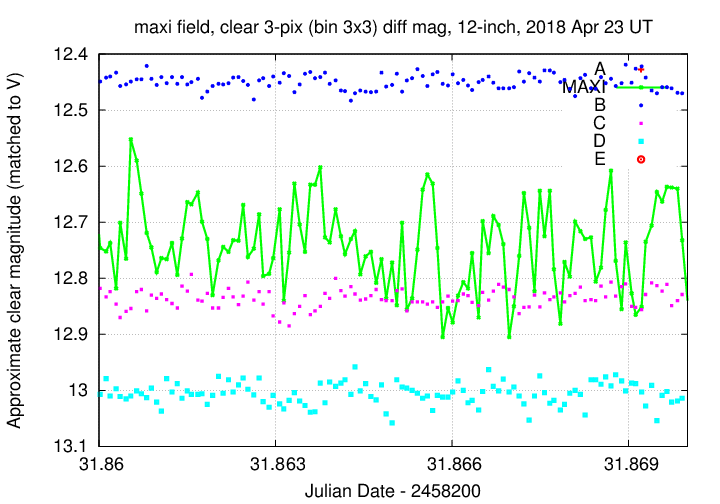
You can download my measurements below. A copy of the header of the file is shown to explain the format.
# Measurements of MAXIJ1820+070 made at RIT Obs, UT 2018 Apr 23, # in good conditions, # by Michael Richmond, # using Meade 12-inch LX200 and ATIK 11000. # Exposures 5 seconds long, no filter. # Tabulated times are midexposure (FITS header time - half exposure length) # and accurate only to +/- 1 second (??). # 'mag' is a differential magnitude based on ensemble photometry # using a circular aperture of radius 3 pix = 5.9 arcseconds. # which has been shifted so UCAC4 486-079513 has mag=12.454 # which is its V-band magnitude according to UCAC4. # # UT_day JD HJD mag uncert Apr23.28294 2458231.78294 2458231.78521 12.861 0.018 Apr23.28302 2458231.78302 2458231.78529 12.873 0.018 Apr23.28311 2458231.78311 2458231.78538 12.939 0.018
Last modified 4/23/2018 by MWR.